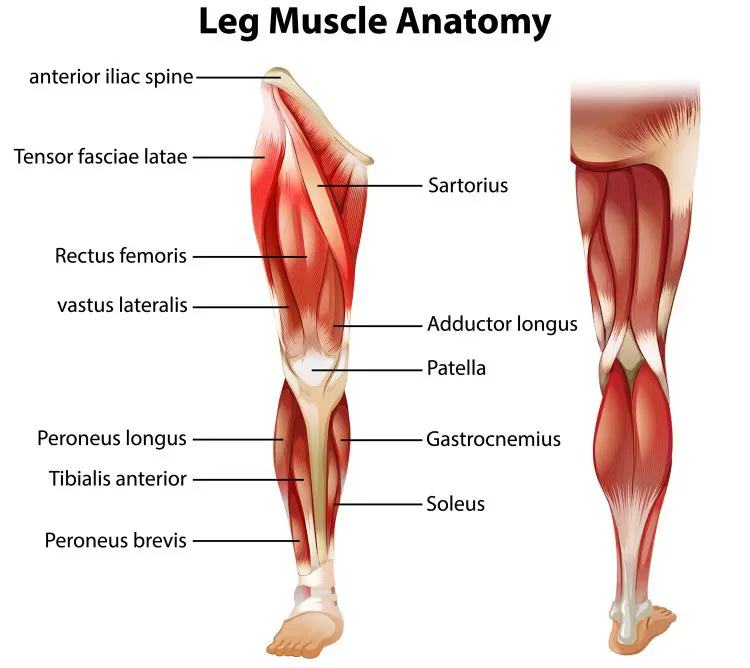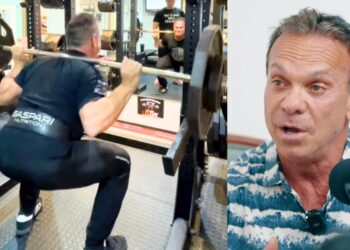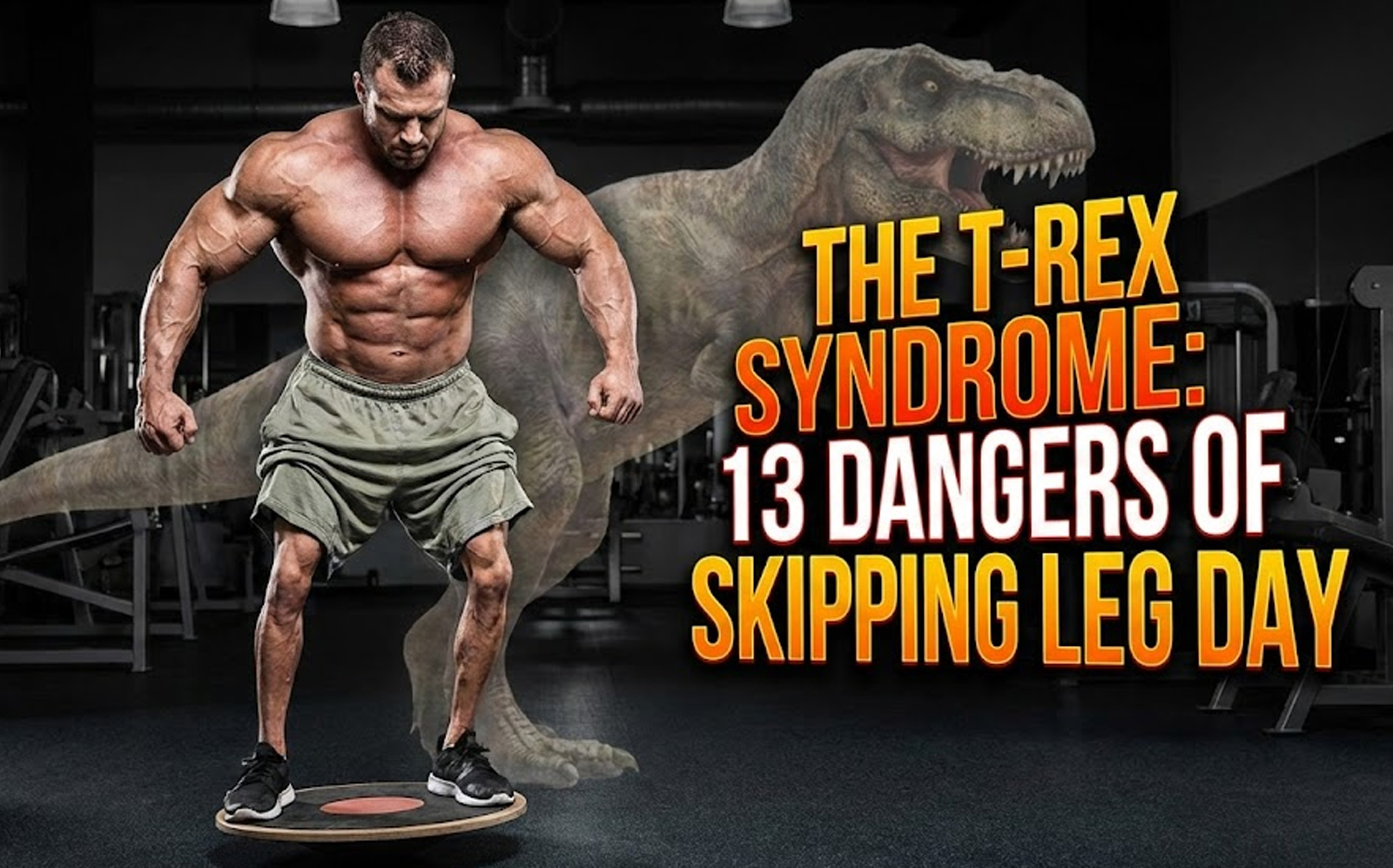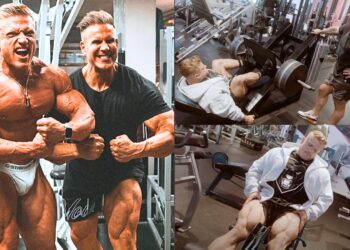As a personal trainer with over 35 years of hands-on experience, I am a massive fan of squats and deadlifts. Why? Because they’re arguably the best exercises for building lower body muscle mass and strength. It’s hard to imagine a leg workout without at least one of these mighty movements.
That said, to maintain consistent progress, the best workouts must include a variety of exercises so that you can hit your muscles in different ways and from multiple angles.
That’s why I supplement my (and my clients’) leg workouts with cable machine exercises.
With cable exercises, you can target your muscles with laser-like precision and without overloading your lower back. They’re ideal for hypertrophy and improving muscular endurance. Cable leg exercises are ideal for your second leg workout of the week or those days you want to train your legs without compressing your spine or hammering your knees.
So, in this article, I share 12 of my favorite and the best cable machine leg exercises for bigger, more muscular legs. There’s also a workout for you to try so you can experience the power of cable machine leg exercises for yourself!
Level Up Your Fitness: Join our 💪 strong community in Fitness Volt Newsletter. Get daily inspiration, expert-backed workouts, nutrition tips, the latest in strength sports, and the support you need to reach your goals. Subscribe for free! Recent Updates: On June 21, 2024, Fitness Volt’s Senior Editor Vidur Saini (American Council on Exercise-CPT) updated the article and added actionable expert tips throughout the piece to improve the reader experience.
12 Best Cable Exercises for Legs
Not sure which cable exercises to choose for your leg workouts? Here are 12 of the best!
Add the following movements to your arsenal:
- Cable Goblet Squat
- Cable Pull-Through
- Cable Deadlift
- Cable Stiff-Legged Deadlift
- Cable Squat
- Standing Cable Hip Extension
- Cable Hip Adduction
- Cable Hip Abduction
- Cable Standing Leg Curl
- Cable Prone Leg Curl
- Cable Lunge
- Cable Squat Walkouts
1. Cable Goblet Squat
| Sets & Reps | Equipment Needed | Target Muscles |
| 3 x 8-12 | Cable Machine, V-handle attachment | Quadriceps, Glutes, Hamstrings, Core |
Goblet squats are an excellent exercise for building stronger, more muscular quads. Usually done with a dumbbell or kettlebell, you can also do this exercise using a cable machine. With no weights to drop on your feet, cable goblet squats are an excellent exercise for beginners and more advanced lifters who want to train to failure in complete safety.
“The goblet squat is a great way to teach proper squat mechanics, as holding the weight in front of you naturally encourages an upright torso and proper knee tracking,” says Saini.
How to do it:
- Attach a rope handle or straight bar to a low pulley. Hold your chosen handle in front of your chest and just under your chin. Pull your shoulders down and back and brace your core.
- Take a small step backward and stand with your feet about shoulder-width apart, toes turned slightly outward.
- Bend your knees and squat down until your thighs are roughly parallel to the floor. Do not round your lower back.
- Stand back up and repeat.
- Increase glute engagement by using a booty band around your knees or hit your quads harder by placing your heels on weight plates.
Pro Tip: Initiate the movement by pushing your hips back while maintaining a neutral spine. As you descend, keep the knees tracking over the toes and drive through your heels to ascend, squeezing the glutes at the top.
| Difficulty | Progression | Regression |
| Beginner | Barbell Front Squat | Bodyweight Squat, Box Squat, Assisted Squat Machine |
2. Cable Pull-Through
| Sets & Reps | Equipment Needed | Target Muscles |
| 3 x 8-12 | Cable Machine, Rope attachment | Glutes, Hamstrings, Lower Back |
The cable pull-through can help improve your squat and deadlift performance. Working your entire posterior chain, this is a very back-friendly leg exercise that’s also ideal for general exercisers. Most people tend to feel this exercise most in their glutes, which is why it’s also a favorite of many lifters to develop a shapely, jiggly butt.
Saini adds that cable pull-throughs are an excellent hip hinge movement that emphasizes glute activation and can help improve hip extension strength.
Pro Tip: Avoid movement at the shoulder and elbows to ensure optimal posterior chain stimulation.
| Difficulty | Progression | Regression |
| Beginner | Barbell Hip Thrust | Glute Bridge |
Learn how to do this exercise here.
3. Cable Deadlift
| Sets & Reps | Equipment Needed | Target Muscles |
| 3 x 8-12 | Cable Machine, Straight Bar attachment | Glutes, Hamstrings, Lower Back, Core, Forearms |
Deadlifts are arguably one of the most productive and essential exercises you can do. In fact, they’re so potent that Victorian exercisers (known as physical culturists) called it the health lift. Generally done with a barbell, you can also do a deadlift variation with a cable machine. This tends to be easier on the lower back and safer for beginners.
Per Saini, cable deadlifts provide a unique challenge due to the constant tension from the cable, which can help increase muscle activation throughout the entire range of motion (ROM).
Pro Tip: Engage your lats by pulling your shoulders down and back. Keep the bar close to your body throughout the entire movement, ensuring the hips and shoulders rise simultaneously.
| Difficulty | Progression | Regression |
| Intermediate | Deficit Cable Deadlift, Romanian Deadlift with Dumbbells | RDLs, Kettlebell Deadlift |
Read more about cable deadlifts here.
4. Cable Stiff-Legged Deadlift
| Sets & Reps | Equipment Needed | Target Muscles |
| 3 x 8-12 | Cable Machine, Straight Bar attachment | Hamstrings, Glutes, Lower Back |
Stiff-legged or Romanian deadlifts work your posterior chain, i.e., your glutes, hamstrings, and lower back. Usually done using a barbell or dumbbells, this exercise also works great with a cable machine.
“The stiff-legged deadlift is a fantastic exercise for hamstring development, as it emphasizes the movement’s eccentric (lowering) phase,” says Saini.
How to do it:
- Attach a bar or rope handle to a low pulley. Then, grab the handle, stand up, and take 1-2 steps back to tension the cable.
- Stand with your feet between shoulder and hip-width apart, knees slightly bent. Brace your core and pull your shoulders down and back.
- Push your butt back and hinge forward from your hips, extending your arms out in front of you. Do not round your lower back.
- Drive your hips forward and stand back up, tensing your glutes as you do so.
- Repeat for the desired number of repetitions.
Pro Tip: Focus on keeping a slight bend in the knees throughout the movement, feeling the stretch in your hamstrings as you hinge forward, and avoid rounding your back.
| Difficulty | Progression | Regression |
| Intermediate | Increase weight, Single-Leg Cable Stiff-Legged Deadlift, Barbell Romanian Deadlift | Good Mornings, Bodyweight Good Mornings |
5. Cable Squat
| Sets & Reps | Equipment Needed | Target Muscles |
| 3 x 8-12 | Cable Machine, Shoulder harness attachment | Quadriceps, Glutes, Hamstrings, Core |
Cable squats put more stress on your quadriceps and less on your gluteus maximus and hamstrings. They are more comfortable and easier to master than barbell squats, making them a better choice for beginners.
Saini adds that cable squats offer a different loading pattern than barbell squats, reducing stress on the spine while effectively targeting the quadriceps and glutes.
Pro Tip: Maintain an upright torso and a neutral spine throughout the movement. Drive through your heels as you ascend, and avoid allowing your knees to cave inward.
| Difficulty | Progression | Regression |
| Intermediate | Barbell Back Squat | Bodyweight Squat, Box Squat |
Learn how to do cable squats here.
6. Standing Cable Hip Extension
| Sets & Reps | Equipment Needed | Target Muscles |
| 3 x 10-15 (each leg) | Cable Machine, Ankle cuff attachment | Glutes, Hamstrings |
Adding an ankle cuff to your cable machine leg workout means you can do a much larger range of lower-body exercises. Cable hip extensions target your glutes. Unlike things like pull-throughs and stiff-legged deadlifts, this exercise involves minimal lower back stress and allows you to focus all your attention on your butt, training one side at a time.
Saini shares that this exercise isolates the gluteus maximus and hamstrings, promoting hip extension strength and stability.
Pro Tip: Focus on squeezing the glutes at the movement’s top, and avoid hyperextending your lower back. Control the eccentric phase for maximum muscle activation.
| Difficulty | Progression | Regression |
| Beginner | Standing Cable Hip Extension with resistance band, Glute-Ham Raise | Glute Bridge |
Find out more about this glute-busting exercise here.
7. Cable Hip Adduction
| Sets & Reps | Equipment Needed | Target Muscles |
| 3 x 10-15 (each leg) | Cable Machine, Ankle cuff attachment | Adductors (Inner Thigh) |
Your hip adductors are located on the inside of your thighs. Three muscles make up this group: adductor longus, adductor brevis, and adductor magnus. While these muscles are involved in most lower body exercises, they work as stabilizers.
With cable hip adduction, they’re promoted to a starring role. If you want to focus exclusively on your inner thighs, this is the cable exercise for you.
Saini says that hip adductor exercises are often neglected, but they play a crucial role in hip stability and can help prevent groin injuries.
Level Up Your Fitness: Join our 💪 strong community in Fitness Volt Newsletter. Get daily inspiration, expert-backed workouts, nutrition tips, the latest in strength sports, and the support you need to reach your goals. Subscribe for free! Pro Tip: Keep your core engaged and slightly bend the standing leg. Focus on a controlled movement, avoiding any swinging or momentum.
| Difficulty | Progression | Regression |
| Beginner | Standing Cable Hip Adduction with a resistance band, Side-Lying Hip Adduction | Seated Hip Adduction Machine, Side-Lying Hip Adduction with bodyweight |
Learn how to do this exercise here.
8. Cable Hip Abduction
| Sets & Reps | Equipment Needed | Target Muscles |
| 3 x 10-15 (each leg) | Cable Machine, Ankle cuff attachment | Abductors (Outer Thigh), Glutes |
While the adductors are on the inside of your thighs, the abductors are on the outside of your legs and butt. Consisting of your gluteus minimus and medius, as well as the tensor fascia latae, these muscles lift your legs out and away from the midline of your body. Using a cable machine and a cuff is one of the most effective ways to train the abductors.
Saini reveals that strong hip abductors are essential for lateral stability and can help improve athletic performance in activities like running and jumping.
Pro Tip: Maintain a neutral spine and avoid leaning excessively to the side. Focus on squeezing the glutes and abductors at the top of the movement.
| Difficulty | Progression | Regression |
| Beginner | Standing Cable Hip Abduction with a resistance band, Lateral Band Walk | Seated Hip Abduction Machine |
Learn how to do cable hip abductions here.
9. Cable Standing Leg Curl
| Sets & Reps | Equipment Needed | Target Muscles |
| 3 x 10-15 (each leg) | Cable Machine, Ankle cuff attachment | Hamstrings |
Leg curls isolate your hamstrings. However, regular leg curls only involve knee flexion, which is just one of the functions of this mighty muscle group. Cable leg curls combine knee flexion with hip extension to provide a more comprehensive hamstring workout.
The standing leg curl allows for a greater range of motion than lying leg curls, potentially leading to greater hamstring activation, says Saini.
How to do it:
- Put a cuff around your ankle and attach it to a low pulley machine. Stand facing the weight stack and use your arms for balance.
- Shift your weight onto your supporting leg and brace your core.
- Extend your leg backward and simultaneously bend your knee, curling your foot up toward your butt.
- Lower your foot back to the floor and repeat.
- Do the same number of reps on both legs.
Pro Tip: Keep your torso upright and avoid swinging your leg. Focus on contracting the hamstrings throughout the entire movement.
| Difficulty | Progression | Regression |
| Beginner | Increase weight, Single-Leg Cable Standing Leg Curl, Nordic Ham Curl | Lying Leg Curl Machine, Glute-Ham Raise (assisted) |
10. Cable Prone Leg Curl
| Sets & Reps | Equipment Needed | Target Muscles |
| 3 x 10-15 | Cable Machine, Bench, Ankle cuff attachment | Hamstrings |
The leg curl machine is arguably the most convenient way to isolate your hamstrings, but it’s not the only way. Cable prone leg curls might not be quite as straightforward, but they’re just as effective.
Saini recommends this exercise to people who don’t have a lying leg curl machine at the gym. The hamstring isolation is unmatchable.
How to do it:
- Put a cuff around both ankles. With your feet nearest the pulley, lie on your front next to a cable machine. Rest your head on your folded arms for comfort.
- Ask your training partner to attach the low cable to your cuffs. Move forward to tension the cable if necessary.
- Bend your legs and curl your feet up to your butt.
- Extend your legs and repeat.
Pro Tip: Maintain a neutral spine and avoid arching your back. Focus on a controlled movement, squeezing the hamstrings at the top of each rep.
| Difficulty | Progression | Regression |
| Beginner | Stability Ball Leg Curl, Nordic Ham Curl | Lying Leg Curl Machine, Glute-Ham Raise (assisted) |
11. Cable Lunge
| Sets & Reps | Equipment Needed | Target Muscles |
| 3 x 10-12 (each leg) | Cable Machine, Shoulder harness or D-handles | Quadriceps, Glutes, Hamstrings |
Lunges are a very effective exercise, and using a cable machine makes them even better! With this lunging variation, the cable pulls you forward, so you’ll have to work harder to decelerate as you descend and also as you push back off your front leg to return to the starting position. This overloads your quads, leading to a more challenging workout.
Saini adds that the cable lunges offer a unique challenge due to the constant tension from the cable, making them an effective exercise for building single-leg strength and stability.
How to do it:
- Attach a D-shaped handle or rope handle to a low pulley. Hold it with both hands and then take 1-2 steps back to tension the cable. Stand up tall, brace your abs, and pull your shoulders down and back.
- Take a large step forward, bend your legs, and lower your rearmost knee down to within an inch of the floor.
- Push off your front leg and return to the starting position.
- Do your next rep with the same leg or alternate sides as preferred.
Pro Tip: As you lunge forward, ensure your front knee tracks over your toes, and avoid letting it cave inward.
| Difficulty | Progression | Regression |
| Intermediate | Cable Reverse Lunge, Walking Lunges with Dumbbells | Static Lunges, Assisted Lunges |
12. Cable Squat Walkouts
| Sets & Reps | Equipment Needed | Target Muscles |
| 3 x 8-10 | Cable Machine, Shoulder harness attachment | Quadriceps, Glutes, Hamstrings, Core |
This exercise is a variation of the wall sit. The only difference is that you’ll be moving forward and backward in the squat position instead of leaning against a wall. This exercise will leave your legs burning and begging for mercy!
“Cable squat walkouts are a challenging exercise that combines squatting and lunging patterns, targeting multiple muscle groups and improving overall lower body strength and endurance,” says Saini.
How to do it:
- Attach a rope handle or straight bar handle to a low pulley.
- Grab the handle, extend your arms, walk back 1-2 steps.
- Get into a squat position with your thighs roughly parallel to the floor and your torso upright. Do not round your lower back. Brace your core and pull your shoulders down and back.
- Maintaining the squat position, take 5-6 steps small backward followed by 5-6 steps forward.
- Keep your weight on your heels for maximum glute engagement. Make sure that your knees don’t collapse inwards.
- One trip forward and backward is one rep, so keep going!
Pro Tip: Maintain a tight core and a neutral spine as you walk out. Avoid rushing the movement, and focus on controlled squats with proper depth.
| Difficulty | Progression | Regression |
| Intermediate | Barbell squats, Zercher squats | Cable squats |
Cable Machine Leg Workout
While you could just pick a few cable leg exercises and hope for the best, you’ll get better results if you follow a balanced training program. Do this workout 1-2 times per week to develop the lower body of your dreams. If you do it twice, make sure there are a couple of days between workouts to allow time for repair and recovery, e.g., Monday and Thursday.
Before you start, make sure you warm up your legs with a few minutes of light cardio followed by dynamic mobility and flexibility exercises for your ankles, knees, hips, and lower back.
All of the exercises in this program are described above.
| No. | Exercise | Sets | Reps | Recovery |
| 1 | Cable goblet squat | 4 | 8-10 | 90 seconds |
| 2 | Cable stiff-legged deadlift | 4 | 8-10 | 90 seconds |
| 3 | Cable lunge | 3 | 10-12 | 60 seconds |
| 4 | Cable prone leg curl | 3 | 10-12 | 60 seconds |
| 5 | Cable hip abduction | 2 | 12-15 | 45 seconds |
| 6 | Cable squat walkouts | 2 | 6-8 | 45 seconds |
Leg Anatomy 101
Knowing a little more about the muscles that make up your lower body will help you write better bodybuilding programs and leg workouts and help you choose the best exercises for your goals.
The main muscles that make up your legs are:
Quadriceps:
Known as the quads for short and located on the front of your thighs, this muscle group extends your knee joint. The four quadriceps are the rectus femoris, vastus lateralis, vastus medialis, and vastus intermedius. The rectus femoris is also involved in hip flexion.
Hamstrings
Located on the back of your thigh, the hamstrings flex your knees and extend your hips. The three hamstrings are the biceps femoris (the leg biceps), semimembranosus, and semitendinosus.
Gluteus maximus
Called the glutes for short, this large muscle is basically your butt. It works with your hamstrings to extend your hip.
Hip adductors – located on the inside of your thighs, the hip adductors pull your legs into the midline of your body. There are three adductors: longus, brevis, and magnus.
Hip abductors
The hip abductors lift your leg out and away from the midline of your body. Located on the side of your hip and thigh, the abductor muscles are the gluteus medius and minimus and tensor fascia latae.
Triceps surae
This is the collective name for the two calf muscles: the gastrocnemius and soleus. Together, these muscles extend your ankles in a movement called plantar flexion. There are very few worthwhile cable exercises for the calves. Still, this muscle group is easy to develop using simple bodyweight exercises, such as single-leg standing calf raises on the edge of a step.
Wrapping Up
Don’t think for a moment I’m telling you to give up squats and deadlifts; that would be sacrilegious! However, if you want to develop a strong, muscular, well-balanced lower body, supplementing your free-weight leg workouts with some cable exercises should help.
Using cables means that you can train hard without overloading your spine and target individual leg muscles more precisely for optimal balance and function. Using cables will also add some variety to your leg workouts, and variety is critical for avoiding training plateaus.
Of course, you could go all cables, all the time, especially if you need a break from heavy barbells. Try our cable-only leg workout to experience the power of these exercises for yourself.
Interested in measuring your progress? Check out our strength standards for Hip Adduction, Zercher Squat, Good Morning, and more.









